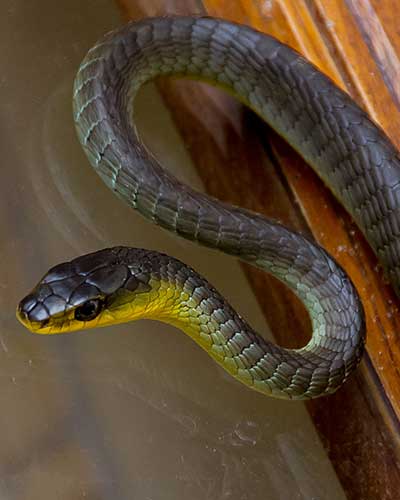Common Tree Snake
Snakes of South East Queensland
Common Tree Snake
Dendrelaphis punctulata
Other common names: Common Tree Snake, Yellow-bellied Black Snake, Grass Snake.

Species Profile
Significance to Humans
Non-Venomous
More often than not the common tree snake is inoffensive and bites infrequently. Emits a strong odour from the cloaca if handled firmly.
General description
The common tree snake is characterised by having a sleek slender body with long, very thin tail. Distinctive ridge extends along outer edges of belly making shed skins easily identifiable. Often quite variable, it has a wide colour ranges from green, olive, brown & black to rare blue-grey on upper body. Belly yellow or creamy, with bright yellow present on throat. Some specimens with blue or grey belly but generally maintain the yellow coloration above the ventral ridges. Skin between the scales when spread show as a light sky blue especially after consuming a meal larger than its body diameter or when defensive. Eye appears large comparative to head. Midbody scales at 11 -13 rows (rarely 15).
Average Length
1.2 metres but a specimen of 1.96 metres has been recorded.
Habitat in SE Qld
Wide range of habitats from the periphery of rainforest, wet sclerophyll forests, dry woodland, farmland, and suburban backyards and gardens throughout the region.
General habits
Diurnal (Active by day) it is a fast and agile species which is equally at home on the ground as much as in the arboreal habitats by which its name suggests. Not only is it an agile climber but also a good swimmer like most snake species.
Diet
An active searching predator that targets predominantly frogs and skinks. Males attain a smaller size than females and this is reflected in the prey selection by individuals. Males typically target slender prey such as geckoes, skinks and small frog species. Females however are known to take small blue tongue skinks and large Common Tree Frogs.
Local distribution
Common & widespread throughout Brisbane. Found in all suburbs including the highly trafficked inner city environs of the Brisbane CBD.
Around the home
Probably the most common species to enter homes due to its highly active foraging nature. Generally above ground environs such as heavy foliage of trees and shrubs, exposed beams of verandahs and pergolas, sheds and garages. Fast-moving and hard to see in heavy cover. Have exploited the abundant supply of Asian house Geckoes, high densities of skinks and presence of frogs in continually watered localities associated with suburban environments thus accounting for there frequency around homes.
Photo Gallery
Please be patient while our image gallery loads. If viewing images in the lightbox viewer by clicking on an image, please allow a few second between each image as some images are large to retain their quality and size. Images are loaded straight from Dropbox, if blank spaces appear in gallery please click on the refresh icon top left of gallery.
All image are the property of the website or respected owner and can not be re-used without permission. Copyright applies
Photo ID 
Did you know WildlifeQld offers a snake & Lizard identification service. For our identification service simply use the upload form on www.snakecatchers.com.au We provide our Australian snake identification service free of charge and always welcome high quality images for potential inclusion on our website. This service is not just for Queensland snake identification but for all snake id across Australia.
The content on this page is intended only to provide a summary and general overview . It is not intended to be comprehensive nor does it constitute to be exact in every circumstances. We attempt to ensure that the Content is current but we do not guarantee its currency.
